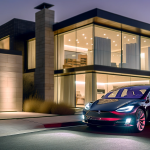Tesla has initiated a unique advertising campaign in New York City, showcasing a Model Y encased in glass and towed by a Cybertruck. This spectacle serves as a mobile gallery, traveling to various iconic locations around the city. The display proudly declares the Model Y as the “Best-Selling Car in the World,” a title it earned last year according to preliminary data from JATO Dynamics. This marketing strategy not only highlights the vehicle’s success but also reinforces Tesla’s image as an innovator in the automotive industry.
Tesla’s approach to advertising has been unconventional from the start, often relying on the spectacle and word-of-mouth rather than traditional marketing methods. In the past, the company has demonstrated its flair for the dramatic, with stunts like launching a Tesla Roadster into space or unveiling new models with surprise features. This latest mobile gallery in NYC is a continuation of Tesla’s strategy to generate buzz and captivate the public’s attention without relying on mainstream advertising avenues. These tactics have helped the brand cultivate a unique and strong position within the automotive market.
What Locations Has the Mobile Gallery Visited?
The mobile gallery featuring the Model Y has made its way through New York City, stopping at landmarks such as Lincoln Center, the Metropolitan Museum of Art, Times Square, and more. Tesla North America has been actively updating the public on the display’s whereabouts via social media, allowing fans and the curious to view the towed spectacle in person. The campaign, which ran throughout a weekend, aimed to maximize exposure by visiting high-traffic areas and engaging onlookers.
How Is Tesla’s Marketing Strategy Evolving?
Tesla’s latest venture into advertising marks a distinct shift in their marketing strategy. Historically, the company has eschewed traditional advertising in favor of direct engagement with customers and fans. This has included social media interaction, referral programs, and high-profile events. Tesla’s decision to take the Cybertruck on tour, towing a Model Y through the streets of NYC, represents their growing focus on creating visually compelling narratives that resonate with a global audience and emphasize the company’s American manufacturing roots.
What Does This Mean for Tesla’s Brand Image?
By showcasing the Cybertruck and Model Y in a mobile gallery, Tesla reinforces its brand image as a leader in American innovation and manufacturing. This move not only advertises the vehicles but also subtly promotes Tesla’s commitment to sustainability and advanced technology. As the vehicles journey from sight to sight, the display serves not only as an advertisement but also as a rolling testament to Tesla’s ingenuity and the popularity of electric vehicles.
In a study published in the Journal of Marketing Research, titled “The Effectiveness of Marketing Strategies in Social Media,” researchers observed that interactive and visually appealing campaigns on social platforms can significantly enhance brand engagement and customer loyalty. Relating this to Tesla’s campaign, it’s clear that the company’s use of a striking visual display paired with social media updates aims to leverage these findings, potentially increasing their market share and strengthening their brand community.
Points to Consider
- The Model Y’s best-selling status is a testament to Tesla’s market impact.
- Visual advertising, like towing a vehicle through NYC, creates memorable impressions.
- Social media plays a critical role in amplifying Tesla’s innovative marketing campaigns.
As Tesla’s Cybertruck tows a glass-encased Model Y through the heart of New York City, the spectacle underscores the company’s commitment to innovative advertising and brand storytelling. By turning heads and sparking conversations, Tesla not only promotes the Model Y but also solidifies its presence as a bold, American-made brand in the public eye. The effectiveness of such a campaign will likely further cement Tesla’s reputation for challenging traditional marketing norms and setting trends in the automotive industry.










